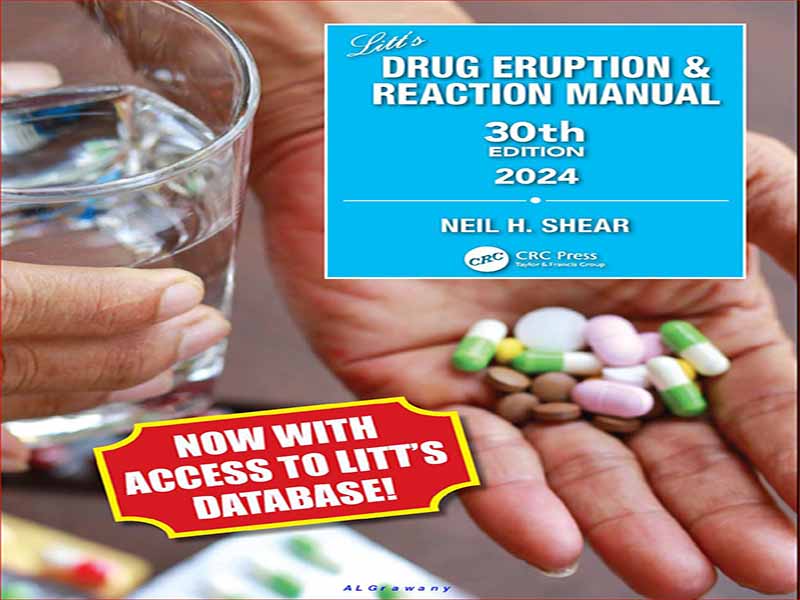- عنوان کتاب: DRUG ERUPTION & REACTION MANUAL
- نویسنده: Neil H. Shear, MD, FRCPC, FACP
- حوزه: دارو سازی, واکنش دارویی
- سال انتشار: 2024
- تعداد صفحه: 531
- زبان اصلی: انگلیسی
- نوع فایل: pdf
- حجم فایل: 9.51 مگابایت
فارماکولوژی پزشکی در درجه اول به مکانیسم هایی می پردازد که به وسیله آنها داروها فرآیندهای بیماری را درمان می کنند، علائم را تسکین می دهند و با تظاهرات مولکولی حالات پاتولوژیک مقابله می کنند. فارماکولوژی همچنین به عواملی می پردازد که دوره زمانی اثر دارو را تعیین می کنند، از جمله جذب، توزیع، متابولیسم و دفع دارو. دانشآموزان اغلب تحت تأثیر حجم وسیع اطلاعات دارویی موجود امروزی قرار میگیرند. این کتاب درسی مفاهیم اساسی و اطلاعات دارویی را که دانشآموزان برای موفقیت در دورههای خود بدون جزئیات زیاد نیاز دارند، ارائه میکند. این متن در درجه اول برای دانشجویانی است که اولین دوره خود را در فارماکولوژی می گذرانند، اما برای کسانی که در حال آماده شدن برای شرکت در بوردهای پزشکی یا امتحانات مجوز هستند نیز مفید خواهد بود. به دلیل تعداد زیادی از داروهای موجود امروزه، این متن بر ویژگیهای کلی دستهبندیهای دارویی و داروهای اولیه تأکید دارد. فصل ها با یک کادر طبقه بندی داروها شروع می شوند تا دانش آموزان با دسته بندی ها، زیرمجموعه ها و داروهای خاصی که در فصل ارائه می شوند آشنا شوند. علاوه بر این، تمام داروهای مورد تایید FDA به همراه داروهای مورد تاکید برای افزایش ارزش این کتاب درسی به عنوان یک جلد مرجع فهرست شده است. در چهار سال پس از انتشار نسخه قبلی فارماکولوژی برنر و استیونز، روندهای عمده در توسعه و بازاریابی داروهای جدید و فرمولاسیون های جدید آشکار شد. اول، انفجاری از داروهای ترکیبی در سال های اخیر به بازار عرضه شد. این چیز خوبی است، زیرا اغلب هم افزایی دارویی بین عوامل ترکیبی وجود دارد، اما همچنین به این دلیل که انطباق بیمار تا حد زیادی بهبود یافته است. مصرف یک قرص راحت تر از دو یا سه یا چهار قرص است. محصول معمولی ترکیبی از دو عامل موفق و موثر برای درمان یک اختلال است. این داروهای ترکیبی تازه تأیید شده در این نسخه ششم از داروسازی Brenner & Stevens گنجانده شده است. دوم، بازار با محصولات دارویی ایمونوفارماکولوژی پر شده است. محصولات ایمونوفارماکولوژی با استفاده از داروهای آنتیبادی مونوکلونال متعددی که در تبلیغات تلویزیونی تبلیغ میشوند، هم برای پزشک و هم برای مصرفکننده آشکار است. تولید دارویی داروهای آنتی بادی مونوکلونال که آنزیمها، گیرندهها یا سایر پروتئینها را هدف قرار میدهند، بخشی از مواد بیولوژیکی است که به سرعت در حال رشد است. بسیاری از کلاس های درمانی عوامل دارویی اکنون دارای یک یا دو دارو هستند که از طریق آنتی بادی ها کار می کنند یا عوامل سیستم ایمنی را هدف قرار می دهند. به دلیل رشد تصاعدی داروهای ایمونوفارماکولوژی، فصل 46 جدیدی برای بستن کتاب اضافه شد. سوم، توسعه و بازاریابی بازدارندههای مولکول کوچک در پنج سال گذشته به شدت افزایش یافته است. مهار کننده های مولکولی کوچک برای ورود به داخل سلول ها و مهار کینازهای خاص یا سایر آنزیم ها و پروتئین ها ساخته شده اند. در مقابل، داروهای سنتی تر، گیرنده یا آنزیم های غشای سلولی را هدف قرار می دهند، مانند مورفین که بر گیرنده های مواد افیونی اثر می کند. مهارکنندههای مولکول کوچک در بسیاری از بیماریهای نئوپلاستیک (سرطانی) و سایر حالتهای پاتولوژیک با یک مسیر مولکولی کاملاً مشخص مؤثر هستند. این دسته جدید از داروها با اهداف درون سلولی به فصل 45 اضافه شد. این کتاب با دقت سازماندهی شده است تا شامل ارجاع متقابل گسترده بسیاری از داروهایی باشد که بیش از یک کاربرد درمانی یا طبقه بندی های متعدد دارند. این به خواننده کمک می کند تا داروی خاصی را دنبال کند که در فصل های مختلف گنجانده شده است. علاوه بر این، برای کمک به خواننده در تشخیص دارو، نام داروها با نام تجاری (برند) در قلم Small Caps دنبال می شود. این کمک می کند زیرا نام تجاری بسیاری از داروها به شدت تبلیغ می شود و خواننده ممکن است قبلاً اطلاعاتی درباره موارد مصرف دارو داشته باشد. از آنجایی که همه داروها با نام ژنریک و نام تجاری آنها نمایه می شوند، این کتاب همچنین مرجع ارزشمندی برای بررسی سریع داروهایی است که در زندگی شخصی یا حرفه ای خواننده با آنها مواجه می شوند. با این حال، خواننده دانشجو به خاطر خواهد داشت که برای اهداف معاینه و تابلوها، نام داروی ژنریک بدون مارک منحصراً استفاده می شود. کتابی که اکنون در دست شماست، به طور گسترده برای ویرایش ششم مورد بازبینی قرار گرفت تا همه داروهای جدید موجود در بازار از آخرین نسخه (بیش از 200) را در بر بگیرد و داروهای قدیمیتری را که از بازار خارج شدهاند حذف کند. بسیاری از اطلاعات دارویی کمکی، مانند ساختارهای شیمیایی و فارماکوکینتیک غیرقابل توجه، کوتاه یا حذف شدند. ارقامی که حفظ شدند، با تاکید بر نشان دادن مکانیسم های اثر دارو، به روز شدند و ارقام جدیدی اضافه شدند. یک سبک گرافیکی مدرن برای فیگورها ایجاد شد تا درک را بهبود بخشد و چشم را مجذوب کند. این نسخه جدید متأسفانه با درگذشت اخیر دکتر جورج M. Brenner، مربی من، دوست من، و نویسنده مشترک در نسخه های قبلی این کتاب درسی مورد توجه قرار گرفته است. جورج من را 30 سال پیش به عنوان یک استادیار جوان فارماکولوژی استخدام کرد، در پروژه های تحقیقاتی همکاری کرد و به شغل من به عنوان یک دانشمند دانشگاهی تشویق کرد. دکتر برنر دانش دایره المعارفی در مورد داروها داشت و تخصص او بسیار ضعیف است
Medical pharmacology is primarily concerned with the mechanisms by which drugs treat disease processes, relieve symptoms, and counteract the molecular manifestations of pathological states. Pharmacology is also concerned with the factors that determine the time course of drug action, including drug absorption, distribution, metabolism, and excretion. Students are often overwhelmed by the vast amount of pharmacological information available today. This textbook provides the essential concepts and drug information that students need to be successful in their courses without an overwhelming amount of detail. This text is primarily intended for students who are taking their first course in pharmacology, but it will also be useful for those who are preparing to take medical boards or licensing examinations. Because of the large number of drugs available today, this text emphasizes the general properties of drug categories and prototypical drugs. The chapters begin with a drug classification box to familiarize students with drug categories, subcategories, and specific drugs to be presented in the chapter. Additionally, all FDA-approved drugs are listed along with the emphasized drugs to enhance the value of this textbook as a reference volume. In the four years since the publication of the previous edition of Brenner and Stevens’ Pharmacology, major trends in the development and marketing of new medications and new formulations were apparent. First, there was an explosion of combination drugs released onto the market in recent years. This is a good thing, as there is often pharmacological synergy between combined agents, but also because patient compliance is greatly improved. It is easier to take one pill than two, or three, or four. The usual product combines two successful and effective single agents for the treatment of a disorder. These newly approved combination drugs are included in this 6th edition of Brenner & Stevens’ Pharmacology. Second, the market is flush with immunopharmacology drug products. Immunopharmacology products are rampant and apparent to both the physician and consumer by the numerous monoclonal antibody drugs touted in TV commercials. Pharmaceutical manufacturing of monoclonal antibody drugs that target enzymes, receptors, or other proteins is a rapidly growing sector of biologicals. Many therapeutic classes of pharmacological agents now have one or two drugs that work via antibodies or that target immune system factors. Because of the exponential growth of immunopharmacology drugs, a new Chapter 46 was added to close the book. Third, the development and marketing of small molecule inhibitors skyrocketed in the last five years. Small molecule inhibitors were developed to go inside of cells and inhibit particular kinases or other enzymes and proteins. By contrast, more traditional drugs target receptor or enzymes on the cell membrane, like morphine acting on opioid receptors. Small molecule inhibitors are effective in many neoplastic (cancer) diseases and other pathological states with a well-defined molecular pathway. This new class of drugs with intracellular targets was added to Chapter 45. The book has been meticulously organized to include extensive cross-referencing of many drugs that have more than one therapeutic use or multiple classifications. This will aid the reader in following a particular drug that is included in different chapters. Additionally, to aid the reader in drug recognition, drug names are followed by trade (brand) names in Small Caps Font. This helps because the trade name of many drugs are heavily advertised and the reader may already have some knowledge of their drug uses. As all medications are indexed under both their generic and brand names, this book is also a valuable reference for a quick review of drugs encountered in the reader’s personal or professional life. However the student reader will bear in mind that for purposes of examination and boards, the unbranded generic drug name is exclusively used. The book now in your hands was extensively revised for the 6th edition to include all new drugs on the market since the last edition (more than 200), and to exclude older drugs that were withdrawn from the market. Much ancillary drug information, such as chemical structures and unremarkable pharmacokinetics, was shortened or deleted. The figures that were retained were updated and new figures added, with an emphasis on illustrating drug mechanisms of action. A modern graphic style was developed for the figures to improve understanding and to entice the eye. This new edition is sadly noted by the recent passing of Dr. George M. Brenner, my mentor, my friend, and co-author on previous editions of this textbook. George hired me 30 years ago as a young Assistant Professor of Pharmacology, collaborated on research projects, and encouraged my career as an academic scientist. Dr. Brenner had an encyclopedic knowledge of medications and his expertise is greatly missed. On another sad note, this book was written during the COVID- 19 pandemic which took hundreds of thousands of lives due to infection with the SARS-CoV-2 virus. Although at the time of this writing there are no fully-approved FDA treatments for the pandemic virus, special sections on the emergency use drugs and developing vaccines are included in Chapter 43 and Chapter 46. I thank my numerous offspring and their mates for their constant love and attention which inspires me to undertake such massive projects like this textbook. I especially want to thank my OB/GYN wife, Dr. Timmeni L. Stevens, D.O., (‘the real doctor’) for her help on Chapter 34, Drugs Affecting Fertility and Reproduction. I also appreciate the fine people at Elsevier, who bring it all together to produce the nicely designed textbook now in your hands. The interactions with Alexandra Mortimer, Meghan Andress, and Kevin Travers were especially professional and pleasant. They seem to really enjoy their career and know what they are doing. Finally, I am a pharmacologist who spent most of my career as a preclinical researcher using animals and cell cultures as models for understanding the human condition. I am not a physician or medical consultant. Therefore none of the following text should be taken as medical advice.
این کتاب را میتوانید بصورت رایگان از لینک زیر دانلود نمایید.
Download: DRUG ERUPTION & REACTION MANUAL



































نظرات کاربران